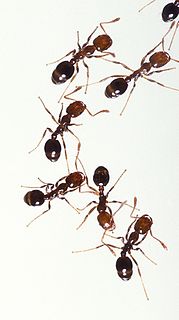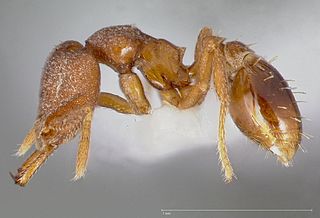
Fire ant is the common name for several species of ants in the genus Solenopsis. They are, however, only a minority in the genus, which includes over 200 species of Solenopsis worldwide. Solenopsis are stinging ants and most of their common names reflect this, for example, ginger ants and tropical fire ants. Many species also are called red ants because of their light brown color, though species of ants in many other genera are similarly named for similar reasons. Examples include Myrmica rubra and Pogonomyrmex barbatus.

Formica is a genus of ants of the family Formicidae, commonly known as wood ants, mound ants, thatching ants, and field ants. Formica is the type genus of the Formicidae, and of the subfamily Formicinae. The type species of genus Formica is the European red wood ant Formica rufa. Ants of this genus tend to be between 4 and 8 mm long.

Lycaenidae is the second-largest family of butterflies, with over 6,000 species worldwide, whose members are also called gossamer-winged butterflies. They constitute about 30% of the known butterfly species.

The Leptotyphlopidae are a family of snakes found in North America, South America, Africa, & Asia. All are fossorial and adapted to burrowing, feeding on ants and termites. Two subfamilies are recognized.

Dolichoderinae is a subfamily of ants, which includes species such as the Argentine ant, the erratic ant, the odorous house ant, and the cone ant. The subfamily presents a great diversity of species throughout the world, distributed in different biogeographic regions, from the Palearctic, Nearctic, Afrotropical region and Malaysia, to the Middle East, Australian, and Neotropical regions.

Iridomyrmex, or the rainbow ant is a genus of ant first described by Austrian entomologist Gustav Mayr in 1862. He placed it in the subfamily Dolichoderinae of the family Formicidae. There are 79 described species and five fossil species. Most of these ants are native to Australia; others are found in several countries and islands in Asia and other areas in Oceania, and they have been introduced to Brazil, New Zealand and the United Arab Emirates. Fossil species are known from China, France and the United States.

Strumigenys is a genus of ants in the subfamily Myrmicinae.
Avitomyrmex is an extinct genus of bulldog ants in the subfamily Myrmeciinae which contains three described species. The genus was described in 2006 from Ypresian stage deposits of British Columbia, Canada. Almost all the specimens collected are queens, with an exception of a single fossilised worker. These ants are large, and the eyes are also large and well developed; a sting is present in one species. The behaviour of these ants may have been similar to extant Myrmeciinae ants, such as foraging solitarily for arthropod prey and never leaving pheromone trails to food sources. Avitomyrmex has not been assigned to any tribe, instead generally being regarded as incertae sedis within Myrmeciinae. However, its identity as an ant has been challenged, although it is undoubtedly a hymenopteran insect.

Myrmeciites is an extinct form genus of bulldog ants in the subfamily Myrmeciinae of the family Formicidae, which contains three described species and two fossils not placed beyond the genus level. Described in 2006 from Ypresian stage deposits, all three of the described species and one unplaced fossil are from British Columbia, Canada, while the second unplaced fossil is from Washington State, USA. These ants were large, with the largest specimens collected reaching 3 centimetres (1.2 in). The behaviour of these ants would have been similar to extant Myrmeciinae ants, such as solitary foraging, nesting either in the soil or trees, and leaving no pheromone trail to food sources. Due to the poor preservation of these ants, their phylogenetic position among Myrmeciinae is unclear, and no type species has been designated. These ants are classified as incertae sedis in Myrmeciinae, but some writers have classified it as incertae sedis within the insect order Hymenoptera. This reclassification, however, has not been accepted; instead, Myrmeciites remains in Myrmeciinae.

Dischidia major, the Malayan urn vine, is an unusual plant. Dischidia is a genus of some 80 species of trailing, twining or scandent, succulent epiphytes found throughout the tropics of Asia through to the western Pacific. They carry modified leaves, offering accommodation to ants, including those of the family Dolichoderinae, and in return gain some sustenance from increased carbon dioxide and nitrogen levels, and a degree of protection from noxious animals and plants. This mutualism trait, known as myrmecophily, is widespread across the plant world and clearly carries considerable benefits for both ants and plant.

Leptomyrmecini is a tribe of Dolichoderinae ants with 16 genera and two extinct genera.

Philidris brunnea is a species of ant in the genus Philidris. Described by Donisthorpe in 1949, the species is endemic to New Guinea.

Philidris cordata is a species of ant in the genus Philidris. Described by Smith in 1859, the species is endemic to Indonesia and New Guinea. This species is a frequent inhabitant of the ant plant genera: Myrmecodia and Hydnophytum.
Philidris cruda is a species of ant in the genus Philidris. Described by Smith in 1860, the species is endemic to Indonesia.
Philidris jiugongshanensis is a species of ant in the genus Philidris. Described in Wang and Wu in 2007, the species is endemic to China.
Philidris pubescens is a species of ant in the genus Philidris. Described by Donisthorpe in 1949, the species is endemic to New Guinea.
Philidris laevigata is a species of ant in the genus Philidris. Described by Emery in 1895, the species is endemic to Burma, India and China.
Philidris nagasau is a species of ant in the genus Philidris. Described by Mann in 1921, the species is endemic to Fiji.
Philidris notiala is a species of ant in the genus Philidris. Described by Zhou and Zheng in 1998, the species is endemic to China.












